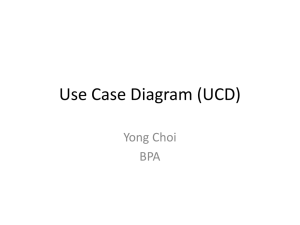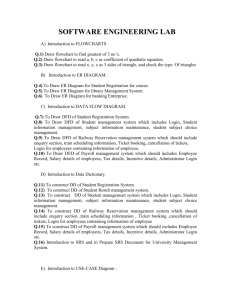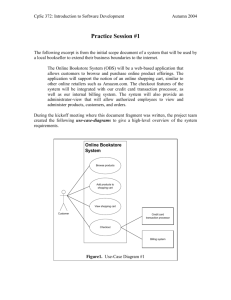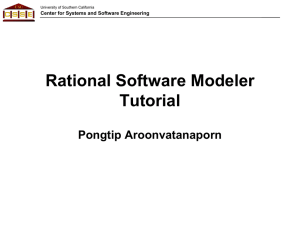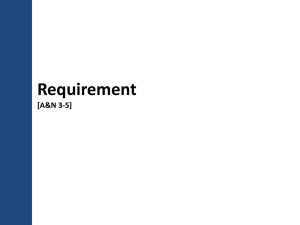software-engineering-lecture-09 - Database
advertisement
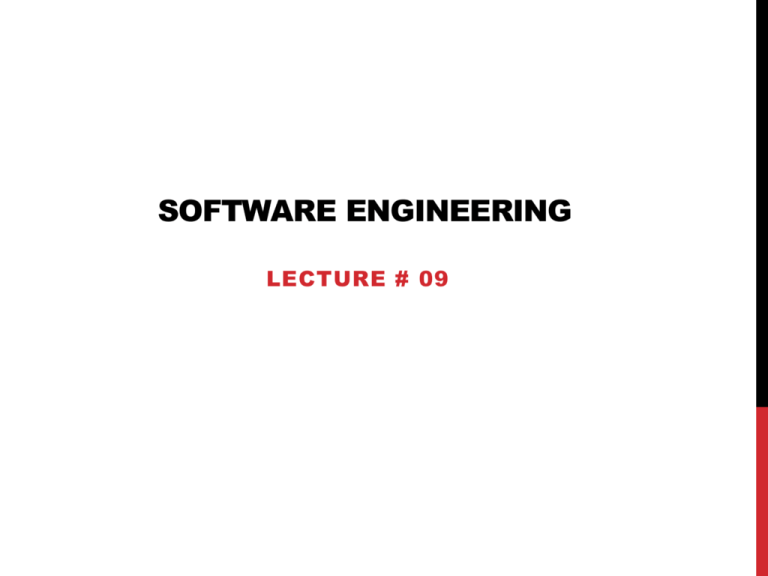
SOFTWARE ENGINEERING LECTURE # 09 2 USE-CASE MODELING WHY WE USE USE-CASE DIAGRAMS Answers the main questions about your system: • Who’s your system’s for? • What must it do? • Why build it in the first place? System users: Actors 3 System normal situations: use-cases WHY WE USE USE-CASE DIAGRAMS Stay focus on your client’s goals A good use case must represent the point of view of the people who will use or interact with the system 4 A complete set of use cases = system requirements USE-CASE DIAGRAM A use-case model is a diagram or set of diagrams that together with some additional documentation show what the proposed software system is designed to do. A use-case diagram consists of three main components: 5 • Actors • Use-cases, and their communications • some additional documentation such as use-case descriptions for elaborating use-cases and problem statements that are initially used for identifying use cases USE-CASE DIAGRAM: ACTORS Usually represented with a stick figure An actor may be: • People • Computer hardware devices • External systems 6 and USE-CASE DIAGRAM: ACTORS 7 An actor represents a role that a user can play, but NOT a specific user Primary actors are those who use the system’s main functions, deriving benefits from it directly. Primary actors are completely outside the system and drive the system requirements Primary actors use the system to achieve an observable user goal Secondary actors play a supporting role to facilitate the primary actors to achieve their goals. Secondary actors often appear to be more inside the system than outside Secondary actors are usually not derived directly from the statement of requirements. Hence, the designer can have more freedom in specifying the roles of these actors Usually found on the right of the system (primary on the left) USE-CASE DIAGRAMS: ACTORS • Actors are treated like classes and thus can be generalized Student BAStudent 8 8 MasterStudent Start by identifying the actors of the system See if the actors can be generalized or not Define the goals of the system and how they can be achieved using the systems’ actors Illustrate these goals and actors actions using use-case diagram(s) 9 USE-CASE DIAGRAMS: ACTORS AND GOALS EBP TEST FOR USE-CASES Elementary Business Process (EBP) is a term from the business process engineering field defined as: A task performed by one person in one place at one time, in response to a business event, which adds a measurable business value and leaves the data in a consistent state 10 • E.g. Approve Credit or Cancel Order 11 USE-CASE DIAGRAM: USE-CASE 12 USE-CASE DIAGRAM: USE-CASE 13 USE-CASE DIAGRAM: USE-CASE USE-CASE DIAGRAM: EXAMPLE System name Association Use-case System boundary 14 Actor USE-CASE DIAGRAM: EXAMPLE 15 Let us consider a simple hotel information system for two types of customers: • Tour Group customers and Individual customers • Tour Group customers are those who have made reservations through a tour operator in advance, while Individual customers make their reservations directly with the hotel • Both types of customers can book, cancel, check-in and checkout of a room by phone or via the Internet 16 USE-CASE DIAGRAM: EXAMPLE STRUCTURING USE-CASES WITH RELATIONSHIPS 17 In the process of developing a use case model, we may discover that some use cases share common behaviors There are also situations where some use cases are very similar but they have some additional behaviors For example, Withdraw Money and Deposit Money both require the user to log-on to an ATM system STRUCTURING USE-CASES WITH RELATIONSHIPS Use Case: Withdraw Money Use Case: Deposit Money Flow of Events: Flow of Events: 1. The user inserts an ATM card. The system prompts the user to enter a password. 2. The user enters the password. The system validates the user password. 1. The user inserts an ATM card. The system prompts the user to enter a password. 2. The user enters the password. The system validates the user password. .... …. …. .... …. …. 18 Common Behavior STRUCTURING USE-CASES WITH RELATIONSHIPS Use Case: Withdraw Money Use Case: Deposit Money Flow of Events: Flow of Events: 1. include (Login Account) .... …. …. 1. include (Login Account) …. …. ….. Use Case: Login Account 1. The user inserts an ATM card. The system prompts the user to enter a password. 2. The user enters the password. The system validates the user password. 19 Flow of Events: THE <<INCLUDE>> RELATIONSHIP 20 Include relationships are used when two or more use cases share some common portion in a flow of events This common portion is then grouped and extracted to form an inclusion use case for sharing among two or more use cases Most use cases in the ATM system example, such as Withdraw Money, Deposit Money or Check Balance, share the inclusion use-case Login Account THE <<INCLUDE>> RELATIONSHIP Withdraw Money Login Account (Included use case) 21 (Base use case) THE <<INCLUDE>> RELATIONSHIP When to use include relationship: The behavior of the inclusion use case is common to two or more use cases The result of the behavior that the inclusion use case specifies, not the behavior itself, is important to the base use case 22 23 THE <<INCLUDE>> RELATIONSHIP: EXAMPLE 24 THE <<INCLUDE>> RELATIONSHIP: EXAMPLE THE <<EXTEND>> RELATIONSHIP In UML modeling, you can use an extend relationship to specify that one use case (extension) extends the behavior of another use case (base) 25 This type of relationship reveals details about a system or application that are typically hidden in a use case THE <<EXTEND>> RELATIONSHIP The extend relationship specifies that the incorporation of the extension use case is dependent on what happens when the base use case executes 26 The extension use case owns the extend relationship. You can specify several extend relationships for a single base use case THE <<EXTEND>> RELATIONSHIP While the base use case is defined independently and is meaningful by itself, the extension use case is not meaningful on its own The extension use case consists of one or several behavior sequences (segments) that describe additional behavior that can incrementally augment the behavior of the base use-case 27 Each segment can be inserted into the base use case at a different point, called an extension point THE <<EXTEND>> RELATIONSHIP Withdraw Money (Base use case) Process Excess Amount (Extending use case) 28 If conditional guard is true, extending flow is executed THE <<EXTEND>> RELATIONSHIP 29 The extension use case can access and modify the attributes of the base use case; however, the base use case is not aware of the extension use case and, therefore, cannot access or modify the attributes and operations of the extension use case THE <<EXTEND>> RELATIONSHIP You can add extend relationships to a model to show the following situations: • A part of a use case that is optional system behavior • A subflow is executed only under certain conditions • A set of behavior segments that may be inserted in a base use case 30 31 THE <<EXTEND>> RELATIONSHIP 32 THE <<EXTEND>> RELATIONSHIP 33 THE <<EXTEND>> RELATIONSHIP 34 THE GENERALIZATION RELATIONSHIP 35 A child use-case can inherit the behaviors, relationships and communication links of a parent use-case (like Actor generalization) In other words, it is valid to put the child use-case at a place wherever a parent use-case appears The relationship between the child use-case and the parent use-case is the generalization relationship For example: suppose the ATM system can be used to pay bills. Pay Bill has two child use cases: Pay Credit Card Bill and Pay Utility Bill 36 THE GENERALIZATION RELATIONSHIP 37 THE GENERALIZATION RELATIONSHIP USE-CASE SCOPE A use case must be initiated by an actor When a use case is considered complete, there are no further inputs or outputs; the desired functionality has been performed, or an error has occurred 38 After a use case has completed, the system is in a state where the use case can be started again, or the system is in an error state BASE USE-CASE VS. ABSTRACT USE-CASE 39 Base use case – invoked directly by actor to achieve an observable goal Abstract use case – invoked by other use cases and is not a complete goal from user’s perspective e.g. withdraw cash (concrete use case) vs. login (abstract use case) 40 USE-CASE SCOPE 41 USE-CASE SCOPE SUMMARY OF NOTATIONS Description Use-case A sequence of transactions performed by a system that produces a measurable result for a particular actor Actor A coherent set of roles that users play when interacting with these use cases System Boundary The boundary between the physical system and the actors who interact with the physical system Notation 42 Construct SUMMARY OF NOTATIONS Description Association The participation of an actor in a use case, i.e. an instance of an actor and instances of a use case communicating with each other Generalization A taxonomic relationship between a general use case and a more specific use case. The arrow head points to the general use case Extend A relationship between an extension use case and a base use case, specifying how the behavior of the extension use case can be inserted into the behavior defined for the base use case. The arrow Notation 43 Construct SUMMARY OF NOTATIONS Description Include A relationship between a base use case and an inclusion use case, specifying how the behavior for the inclusion use case is inserted into the behavior defined for the base use case. The arrow head points to the inclusion use case Notation 44 Construct
